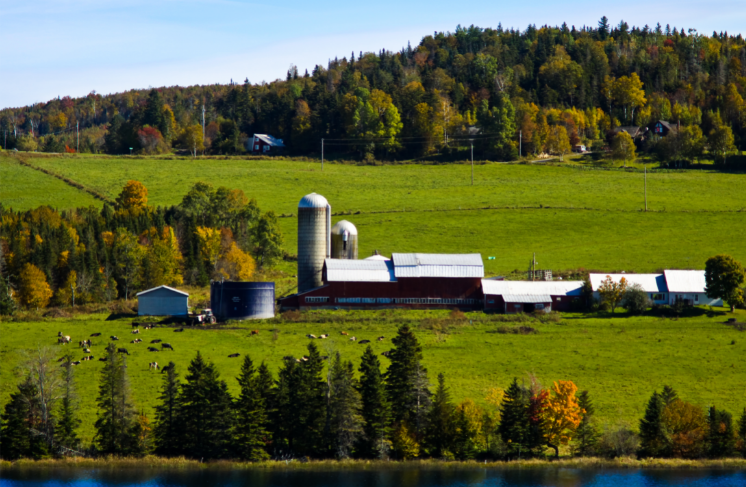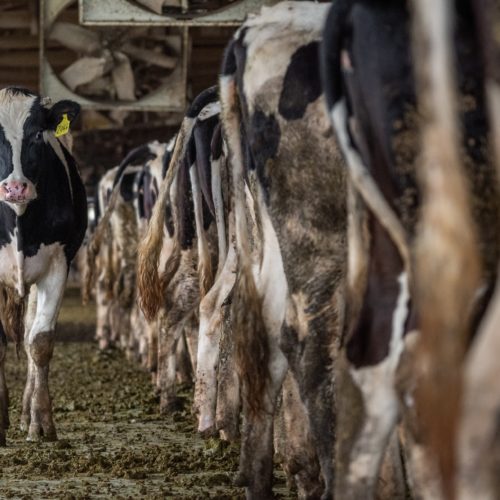Podcast: Farming amid a chronic labor shortage: A conversation with three New Hampshire producers

A dairy farm in New Hampshire. Credit: Canva
We’ve all heard of the Great Resignation: Since the start of the COVID-19 pandemic, a record number of people have quit their jobs in search of better pay and improved working conditions. But in the farm sector, a lack of workers isn’t news at all. The pandemic simply accelerated a slide in the labor force that had been going on for years. It’s a phenomenon that has impacted everything from harvests to food prices – and has prompted some farmers to adapt in creative ways.
In this episode, three New Hampshire farmers explain how they have managed during these uncertain times.
***
Transcript:
Keith Marshall has managed Wilson Farm in Litchfield, New Hampshire, for 32 years. It’s the largest fruit and vegetable farm in the state.
“I don’t know if it’s just a societal change,” said Marshall. I know when I was growing up — I grew up on a farm — and you had a list of kids in the town who wanted to work. You just couldn’t hire them all; you had all kinds of people who wanted to work. And over the years, that’s just changed.”
I met Marshall through my colleagues, Bob Haefner and Tara Sad. They’re former state legislators who spent a decade taking turns chairing the New Hampshire House Agriculture Committee. I reached out to Bob and Tara to try to get a better understanding of the farm labor shortage, and what it means for the future of farming. I reached them via Zoom, as they were getting ready to serve as judges at the Future Farmers of America state convention at Mount Washington.
Bob and Tara explained that now more than ever, it’s critical to foster the next generation of farmers in a field that’s rapidly dwindling in New England. The region has a lot of small, family owned farms — divided mainly between dairy farms, vegetable and fruit farms, and farms that grow ornamental plants, and their numbers have been shrinking, fast.
“Dairy is the toughest sector now,” said Tara. “All the New England states are losing dairy farms drastically every year.”
Tara also mentioned consolidation. In other parts of the country, in states with plenty of wide open spaces and cheap land, massive dairy operations can milk thousands of cows at once, creating economies of scale that small farms simply can’t compete with.
“So, that’s adding to the death of the dairy farmers. But another thing is the lack of labor,” she said. “They just cannot find anybody to milk the cows.”
Bob told this story about a young couple who owned a dairy farm in northern New Hampshire that had been passed down from the man’s grandfather. They were trying to find someone local to milk the cows.
“They hired, over a period of a few weeks, five people for one job,” said Bob. “Two of them never showed up — they took the job and then never showed up — and three others quit before they had been there a week, because the work was too hard.”
Bob thinks the young couple resorted to hiring undocumented workers, but he isn’t sure. It’s no secret that many farms rely on undocumented immigrants to do jobs that Americans won’t. They make up nearly half of the farm labor force, according to USDA, and many of these workers have been here for decades: their children are born here and attend local schools, and they’re assimilated into the community. And yet, they aren’t protected by U.S. labor laws, and they’re perpetually at risk of being arrested by immigration agents and deported. Bob recalled that a few years back, four or five undocumented Mexicans who worked at a large New Hampshire dairy farm went to Walmart one afternoon and were arrested by ICE. There was no one to milk the cows, so their wives and kids had to. Bob doesn’t know how things ultimately turned out for the workers and their families.
“They were given a court date and they went back to work, but I don’t know what happened after that,” he said.
But the labor shortage isn’t just affecting dairy farms. Up at Wilson farm, Keith Marshall told me that over the years, to make up for the lack of local workers, he has used a temp service to hire Cambodian immigrants living in a large community in Lowell, Massachusetts, some 30-35 miles away.
“And they do a great job,” said Marshall. “And, up until a couple of years ago, I had no problem.”
When the pandemic hit, Marshall said that many workers, particularly older ones, were afraid to leave their homes. But he also perceives a broader, societal shift: As the current generation of workers ages, their children have chosen not to follow in their footsteps. The average age of his seasonal workers is now 61 or 62.
“What’s happened is people like myself — and I have three other guys who grew up in this business — and when you grow up in it as a kid you have that work ethic, this is what you know. And that’s ending. You know people that worked on farms. That older generations they don’t have kids anymore, or those kids don’t want to work on the farm,” he said.
Marshall said he is considering turning to the federal H2A program, which allows agricultural employers to hire workers from abroad for temporary or seasonal work, if they can’t fill those positions domestically. He’s certainly not alone: from 2010-2019, requests for foreign workers through the program doubled, according to the U.S. Department of Agriculture.
Challenges with H2A
New Hampshire state Representative Howard Pearl started hiring workers from Jamaica through H2A in the mid-1990s to work on his 300-acre farm. It’s in central New Hampshire, and his family has cultivated the land for four generations, since the 1880s. Before he started hiring from abroad, Pearl was able to employ local labor — high school kids and whoever was around during harvest. He turned to the H2A program when the local pool shrank, but it wasn’t a seamless process.
“That program became quite problematic with the U.S. Department of Labor rules and things that they kept changing, and I constantly found it just to be more of a headache; more and more than it was worth to me,” said Pearl.
It was expensive, and cumbersome, and tiring. The program required Pearl to pay for housing and transport, and the federally mandated minimum wage kept rising. The closest living quarters he was able to find for his workers was a few miles away on another farm. Every morning he would pick them up, and every night he would drive them back.
Pearl eventually decided to leave the H2A program, and for a while, he found workers among a local community of immigrants, many of whom were political refugees from Africa. Then in 2018, he noticed a sharp drop in available labor. Pearl attributed this to several factors, including the booming economy and New Hampshire’s low unemployment rate. Low profit margins in agriculture made it impossible for him to offer wages that could compete with, say, the tech industry, or even fast food restaurants. Once the pandemic hit, it was challenging to find any labor at all.
“The result is that over the last five years — but mostly the last two years — I’ve significantly cut back on what I grow by less than half, because I just do not have the available labor to harvest it,” said Pearl.
“It sounds like a tough decision,” I said. “Was it hard?”
“It was hard, because I’ve spent my whole life growing — getting bigger, and bigger, and bigger, and growing the size of my business,” said Pearl.
That was the summer of 2020. Scaling back made things more manageable, but Pearl still had issues finding labor. During the following summer, 2021, Pearl cut back even more. The reduction in input costs, like fertilizer, seed, and of course, labor, have balanced out his loss in revenue, and he said that he is generally in good shape.
“Harvest-wise we did fine. Obviously, it’s an adaption of my business model that I’ve really had to change,” said Pearl. “I’ve put some of the vegetable land back into hay production, which requires less labor. On the maple side, I rented out some of my taps to neighbors who were interested in growing their own production in their own businesses. It’s just been a real change for me, management-wise,” said Pearl.
Milking cows with robots
On a dairy farm in Hinsdale, in the southwest corner of New Hampshire, Beth Hodge has found a different way to compensate for a lack of local workers, one that reduces her need for humans altogether: mechanization. Hodge says it’s ended up transforming the way she works.
“We really were looking for something that could help us have a lot more flexibility in our schedule, and in fact also help us with some labor challenges that had presented as time has gone on,” said Hodge.
Hodge and her sister started the farm as a 4-H project back in high school. They ship their milk to the cooperative that owns Cabot Cheese, and also make Echo Farm Puddings that they market in grocery stores.
It’s a small, family run dairy farm, the kind that’s typical in New England, except for one major difference: Five years ago, the sisters decided to invest in a robotic milking system. The systems were developed in Europe, and they’ve been used by dairy farmers in this country for at least a decade. Using robots makes Hodge’s job less physically demanding, and it also gives her a lot more flexibility, because she doesn’t need to actually be there to milk the cows.
“So the cow has to make the decision that she wants to be milked,” said Hodge. “And so she walks herself up to the stall and she has a transponder on her neck — like a Fitbit that tells the robot exactly who she is, [and] how long it’s been since she’s been milked.”
Tara, who lives nearby, recently visited the farm to check out the machines. She was pretty impressed with what she observed. Here’s Tara:
“The minute she comes in, the back door closes. She’s chomping away. But at the same time all of this stuff starts happening. Sprayers start spraying underneath her all over her udders, cleaning her off, getting her ready. And then the most amazing thing: the arms come up and just connect to each teat. She doesn’t even move when all this is happening. And then you hear the whirring, the whirring, the whirring of the pumps pumping the milk out. And then, about three minutes into this, one of the suction things falls off. The other three are still pumping. Then another one falls off, and then another one falls off, and then the fourth one falls off eventually, and then all this water starts gushing through the pipes to clean it out for the next one. And then, when all this is done, the arm comes back again. And the cow walks through, the front door opens, and then the back door opens for the next one to come in.”
I said it sounds like the cows get a little more self determination. I asked if I was reading too much into this.
“No, no, that’s absolutely what’s happening,” said Hodge. “They are so much more in charge of what their day looks like and how their routine will be. I can look at the list, and I have certain cows that clearly like the morning more than the afternoon, and they’ll come in in the morning and get milked — and again, rather than me telling her, ‘It’s 2 a.m., you need to get up and go get milked,’ she gets to make those decisions. And so it’s such a different way of operating, and ultimately, just a nicer way, as far as I’m concerned.”
Hodge said that overall production is higher than it would otherwise be. She also doesn’t need to employ as many workers as she used to, and the work is more sophisticated, because she spends a lot of time analyzing data about each cow.
“I always say what it allowed us to do was really change the type of employees we were looking for,” said Hodge.
Hodge doesn’t think the labor shortage is going away, but she said that robotic systems can help to compensate to some extent, and also to attract younger workers because they offer new, creative ways to manage a farm.
“There are a lot of kids that are out there and are excited about agriculture, and so how we make sure we keep them in agriculture is going to be the things that maybe technology will help with,” she said.
But mechanization does have its limits, particularly on fruit and vegetable farms. Marshall of Wilson Farm said that essentially, there’s a machine to pick everything. His farm uses machines to harvest sweet corn, and green and yellow beans. But people in supermarkets like their produce to look perfect; and that requires a softer, human touch.
“If you’re in the processing business, whether it’s tomatoes or carrots, it doesn’t matter what the fruit looks like when it’s picked – it’s going for processing. On the fresh market it’s a lot different,” said Marshall. “A lot of things are labor intensive. For example, we grow a lot of strawberries. It’s very, very labor intensive.
‘My last crop will be houses’
While the pandemic accelerated the shortage of farm labor, it also helped boost land prices, as workers from Boston and other urban areas move to New Hampshire, attracted by the quality of life. Many struggling producers have been tempted to sell their properties to developers. Bob and Tara told me there’s a popular saying among farmers: ‘My last crop is going to be houses.’
“That’s a saying that farmers have been saying for years,” said Tara. “But it’s scary to think that that would be the end of the farmland. And once it’s gone, it’s gone.”
Representative Pearl, the fourth generation farmer, doesn’t think his kids will keep up the tradition. They’re not interested in farming — at least for now. He doesn’t begrudge them; he wants them to pursue meaningful careers. Farming for him is a labor of love, and it’s rewarding in many ways, but not financially.
“Any chance your kids might change their minds?” I asked him.
“I don’t know,” he said. “One, possibly. The other — no.”
Nevertheless, Pearl is determined to ensure that his farm lives on long after him.
“I don’t know what things are going to look like going forward,” said Pearl. “I’m in the process of putting a conservation easement on my farm, to make sure it stays a farm. I don’t know that it’s going to stay Pearl Farm; it may stay someone else’s farm. But it’s going to stay a farm.”





